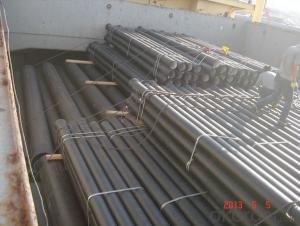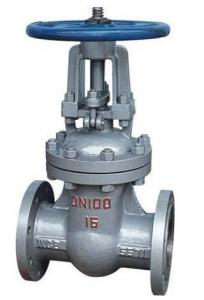T Type Ductile Iron Pipe DN1000 socket spigot pipe
- Loading Port:
- Tianjin
- Payment Terms:
- TT OR LC
- Min Order Qty:
- 25
- Supply Capability:
- 30000 /month
OKorder Service Pledge
OKorder Financial Service
You Might Also Like
1) The standard of pipe: ISO2531:1998, EN545:2006,K9 K8
2) Effective length: 6m/5.7m
3) Inner cement line: Portland cement lineas per ISO4179
4) Zinc coating: at least 130g/m2 as per ISO8179
5) Bitumen painting: at least 70μm as per ISO8179
6)With 102% quantity of NBR, SBR, or EPDM ring asper ISO4633
7) DN80-DN1200
8) Highstrength, lighter than grey iron, good corrosion resistance, no furring, smallflow resistance, easy fixing, long life tome about 100 yeas
9)Checked by automatic inspection equipment
10) Composition:
Chemical composition | |||
Chemical composition | Ductile Cast Iron Pipe (%) | Grey iron pipe (%) | Steel pipe (%) |
C | 3.5-4.0 | 3.2-3.8 | 0.1-0.2 |
Si | 1.9-2.6 | 1.4-2.2 | 0.15-0.4 |
Mn | 0.15-0.45 | 0.4-0.6 | 0.3-0.6 |
P | ≤0.06 | ≤0.3 | 0.02-0.03 |
S | ≤0.02 | ≤0.1 | 0.02-0.03 |
Mg | 0.03-0.06 |
|
|
11) Feature:
Mechanical properties | |||
| Ductile Cast Iron Pipe | Grey Iron Pipe | Steel Pipe |
Tensile Strength(Mpa) | ≥420 | 150-260 | ≥400 |
Yield Strength(Mpa) | ≥300 | No Confirmation | No Confirmation |
Bending Strength(Mpa) | ≥590 | 200-360 | ≥400 |
Elongation (%) | ≥10 | Neglected | ≥18 |
Brinell Hardness(HBS) | ≤230 | ≤230 | About 140 |
12) T type mechanical joint
13) Packing: in bulk or container
PACKING: 1) Pipesare bundled together with the steel belt.
2) Wooden pieces are put between the pipes.
- Q:Are ductile iron pipes available in different wall thicknesses?
- Yes, ductile iron pipes are available in different wall thicknesses. Ductile iron pipes are manufactured with various wall thicknesses to meet different requirements and applications. The wall thickness of a ductile iron pipe is determined based on factors such as the pipe's diameter, the internal pressure it needs to withstand, and the soil conditions it will be installed in. Pipes with thicker walls are typically used for higher pressure applications or in areas with more challenging soil conditions, while thinner-walled pipes may be suitable for lower pressure applications. The availability of different wall thicknesses allows for flexibility in selecting the appropriate ductile iron pipe for specific projects and ensures that the pipes can efficiently and safely transport fluids or gases.
- Q:How are ductile iron pipes tested for hydrostatic pressure?
- For water and wastewater applications, ductile iron pipes are widely used because of their strength and durability. To guarantee their quality and dependability, these pipes undergo hydrostatic pressure testing. The process of hydrostatic pressure testing involves applying internal pressure on the ductile iron pipes at levels higher than their normal operating pressure. This is done to evaluate their ability to withstand the maximum pressure they may encounter during their service life. To begin the testing, a sample set of pipes is carefully selected from a production batch or shipment. These samples are meticulously prepared by removing any surface coatings or debris that could affect the accuracy of the test results. The prepared samples are then placed in a specially designed test rig or test line. The test rig is equipped with all the necessary connections, valves, and gauges to accurately control and monitor the test conditions. Once the samples are secured in the test rig, water or another suitable test fluid is slowly introduced into the pipes. The pressure is gradually increased to a preset level, typically surpassing the expected operating pressure by a certain factor. This elevated pressure is maintained for a specified duration, usually several hours, to evaluate the structural integrity and leak resistance of the pipes. Throughout the test, the pipes are closely monitored for any signs of leakage, deformation, or failure. Skilled technicians or engineers observe the pressure gauges and visually inspect the pipes for any visible defects or abnormalities. Additionally, automated systems may be used to continuously record and analyze the pressure readings, ensuring accurate data collection. After the specified test duration, the pressure is gradually released, and the pipes are meticulously inspected for any permanent deformation or residual stress. This inspection may involve visual examination, dimensional measurements, or non-destructive testing techniques like ultrasonic testing or magnetic particle inspection. The test results are then assessed against the relevant industry standards or specifications to determine if the pipes comply with safety and performance requirements. If the pipes pass the hydrostatic pressure test, they are considered suitable for their intended application. However, if any issues or failures are identified, further investigation, analysis, or corrective actions may be necessary before the pipes can be approved for use. In conclusion, hydrostatic pressure testing plays a vital role in ensuring the quality and reliability of ductile iron pipes. By subjecting these pipes to rigorous testing procedures, manufacturers can provide customers with pipes that meet the highest standards of safety and performance.
- Q:How can stainless steel pipes and ductile iron pipes be joined?
- The stainless steel pipe can be used as a socket or socket, so as to be directly connected with the connection mode of the ductile iron pipe
- Q:Ductile iron gears are generally treated without heat treatment
- The mechanical properties of ductile iron are equivalent to quenched and tempered steel. The gears made of ductile iron can be quenched or tempered by high temperature + surface quenching, that is, quenching and tempering treatment + surface hardening.
- Q:What is the expected thermal expansion of ductile iron pipes?
- The expected thermal expansion of ductile iron pipes is typically around 0.006 inches per inch per degree Fahrenheit.
- Q:How do ductile iron pipes handle water hammer?
- Ductile iron pipes are well-suited to handle water hammer due to their inherent strength and flexibility. The high tensile strength of ductile iron helps absorb and dampen the pressure surges caused by water hammer, preventing any significant damage to the pipes. Additionally, the inherent ductility of these pipes allows them to flex and absorb the impact of water hammer, reducing the likelihood of cracks or bursts. Overall, ductile iron pipes provide a reliable and durable solution for managing water hammer in water distribution systems.
- Q:Can ductile iron pipes be used for irrigation pivot systems?
- Indeed, irrigation pivot systems can utilize ductile iron pipes. Renowned for their robustness, longevity, and resistance to corrosion, ductile iron pipes are apt for numerous purposes, including irrigation. These pipes have the capability to withstand substantial water pressure, guaranteeing a dependable and enduring means of transporting water to irrigation pivot systems. Moreover, ductile iron pipes harmonize seamlessly with a variety of fittings and connectors commonly employed in irrigation systems, thereby facilitating effortless installation and upkeep. All in all, employing ductile iron pipes in irrigation pivot systems emerges as a pragmatic decision that ensures efficacious water distribution while minimizing the likelihood of pipe failure.
- Q:Can ductile iron pipe be used for stormwater systems?
- Ductile iron pipe is indeed suitable for stormwater systems. This material is widely utilized in various applications, including stormwater systems, due to its strength and durability. Its exceptional corrosion resistance makes it ideal for managing stormwater, which frequently contains debris and chemicals. Moreover, ductile iron pipe possesses impressive tensile strength, enabling it to withstand significant amounts of pressure and weight. Therefore, it is a dependable option for stormwater systems that may encounter substantial flow rates and occasional surges. Furthermore, ductile iron pipe is accessible in a variety of sizes and configurations, providing flexibility and adaptability when designing stormwater systems.
- Q:What is the minimum pipe diameter of cast iron pipe?
- Nominal diameter of continuous grey cast iron pipe is 75~1200 mm, minimum 75 mm, maximum 1200 mm.
- Q:How do ductile iron pipes handle concentrated loads?
- Ductile iron pipes are specifically designed to handle concentrated loads effectively. Due to their unique composition and manufacturing process, they possess excellent strength and durability, making them highly resistant to cracking or breaking under heavy loads. One of the key characteristics of ductile iron pipes is their high tensile strength, which enables them to withstand concentrated loads without deformation. The pipes are made by adding small amounts of magnesium to cast iron during the production process, which transforms the brittle graphite flakes into nodular graphite. This modification significantly enhances the material's strength and ductility, allowing it to handle concentrated loads more effectively. Additionally, ductile iron pipes have a high modulus of elasticity, meaning they can deform elastically under a load and then return to their original shape once the load is removed. This property enables the pipes to distribute the concentrated load evenly along their entire length, minimizing stress concentrations and reducing the risk of fractures or failures. Furthermore, ductile iron pipes have a thick, robust wall thickness, providing them with exceptional structural integrity. This thickness allows the pipes to bear significant loads and withstand pressure variations without compromising their overall performance. In summary, ductile iron pipes are specifically engineered to handle concentrated loads due to their high tensile strength, elastic deformation capabilities, and thick wall thickness. These characteristics make them a reliable choice for various applications, including water and wastewater systems, as they can withstand significant external forces without compromising their structural integrity.
1. Manufacturer Overview |
|
|---|---|
| Location | |
| Year Established | |
| Annual Output Value | |
| Main Markets | |
| Company Certifications | |
2. Manufacturer Certificates |
|
|---|---|
| a) Certification Name | |
| Range | |
| Reference | |
| Validity Period | |
3. Manufacturer Capability |
|
|---|---|
| a)Trade Capacity | |
| Nearest Port | |
| Export Percentage | |
| No.of Employees in Trade Department | |
| Language Spoken: | |
| b)Factory Information | |
| Factory Size: | |
| No. of Production Lines | |
| Contract Manufacturing | |
| Product Price Range | |
Send your message to us
T Type Ductile Iron Pipe DN1000 socket spigot pipe
- Loading Port:
- Tianjin
- Payment Terms:
- TT OR LC
- Min Order Qty:
- 25
- Supply Capability:
- 30000 /month
OKorder Service Pledge
OKorder Financial Service
Similar products
New products
Hot products
Related keywords

























